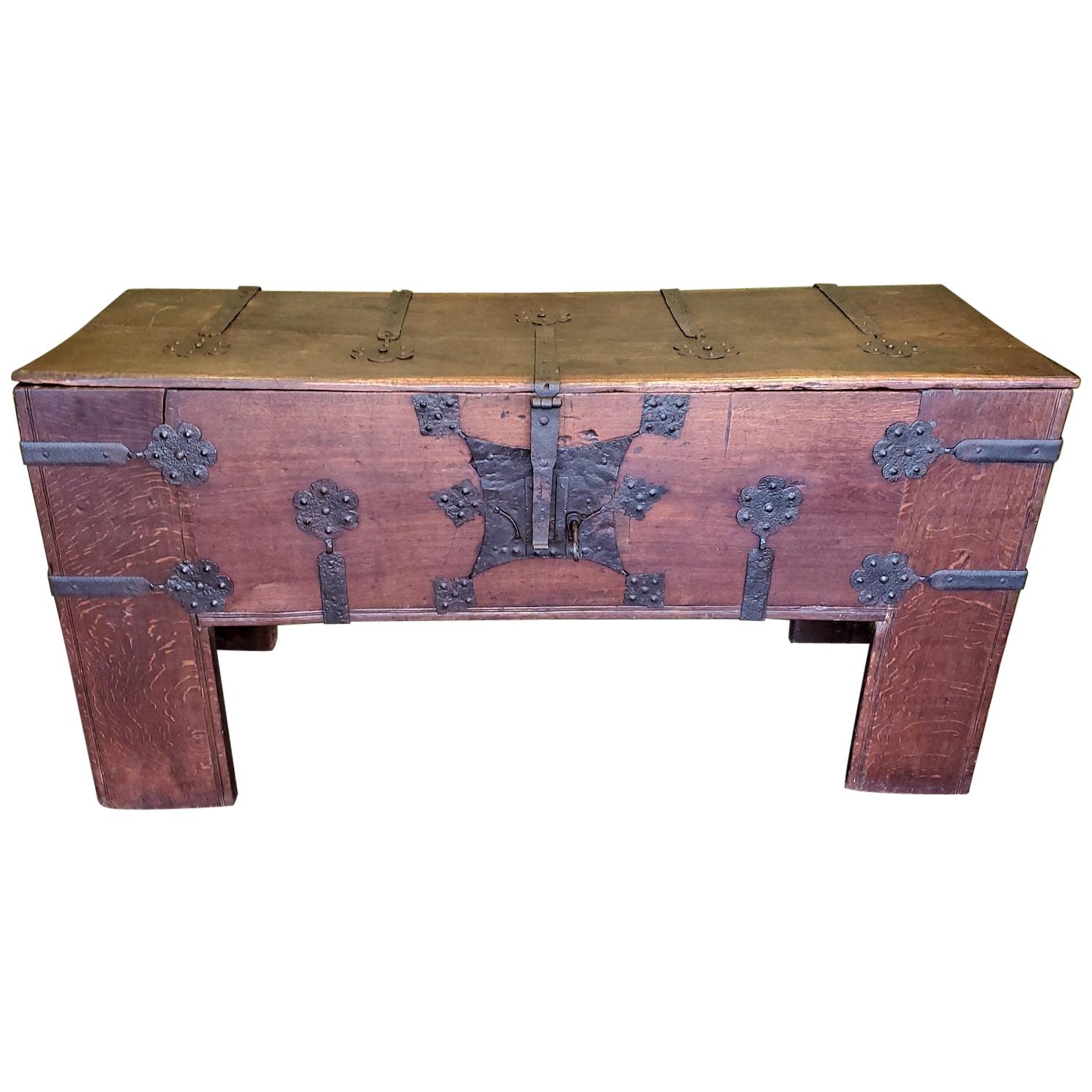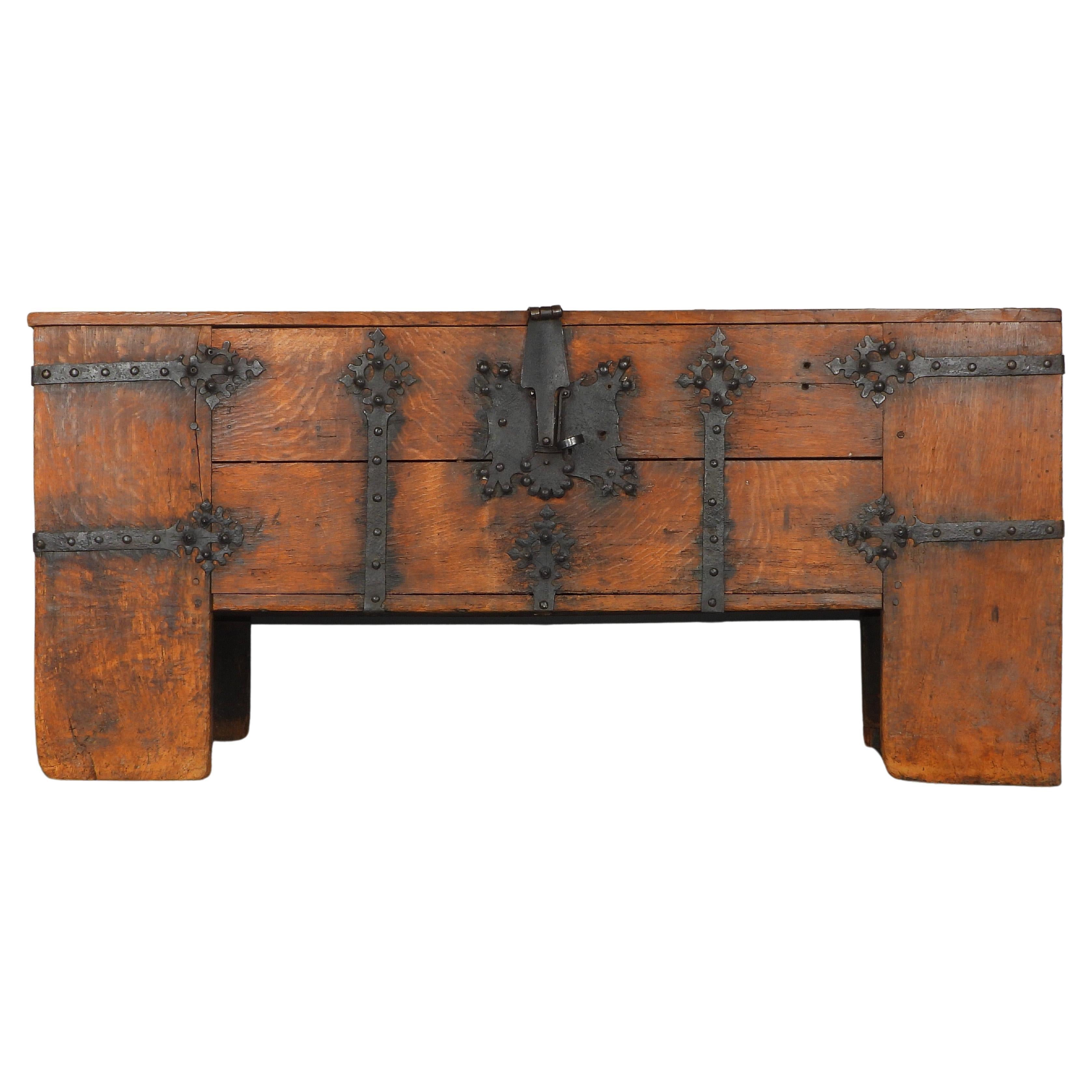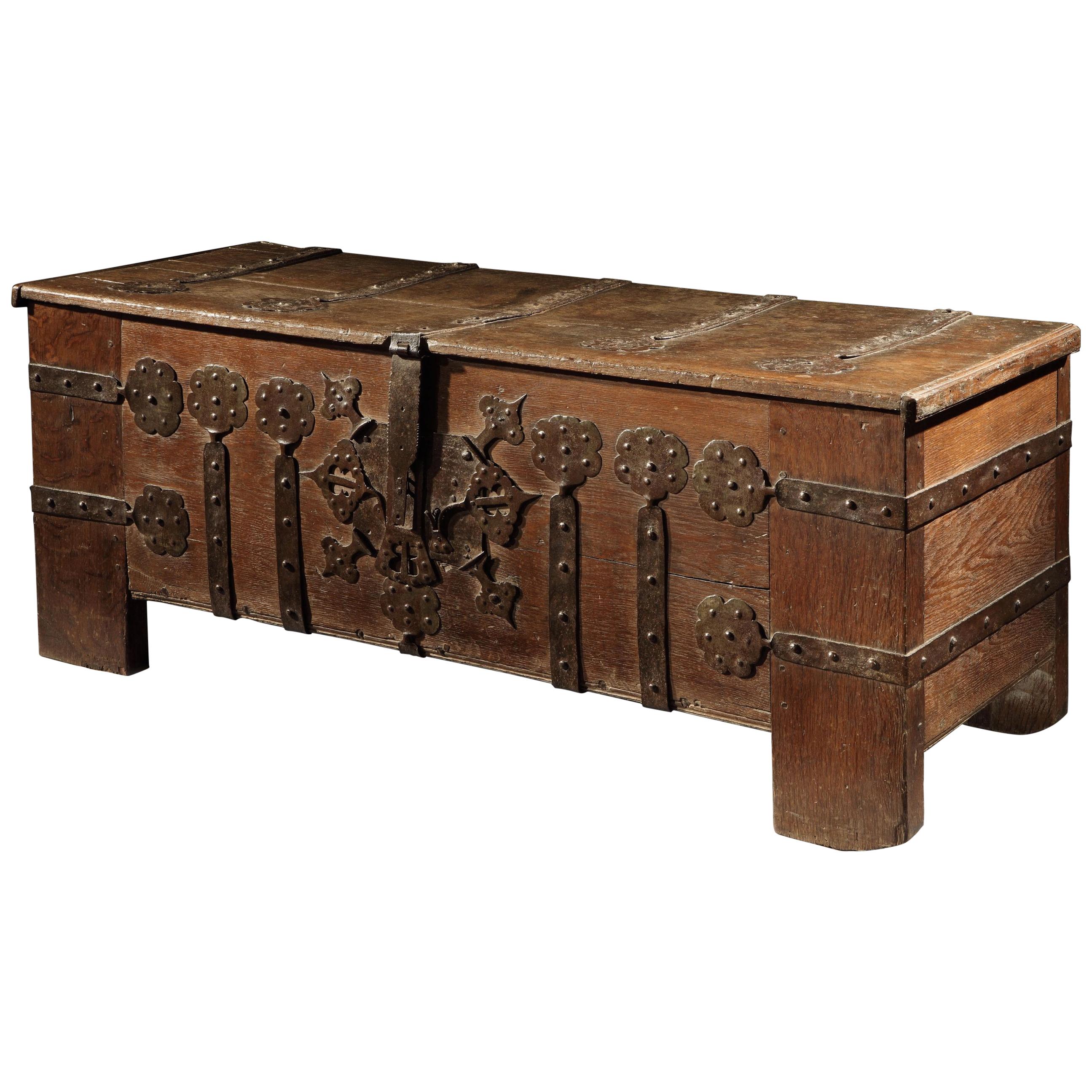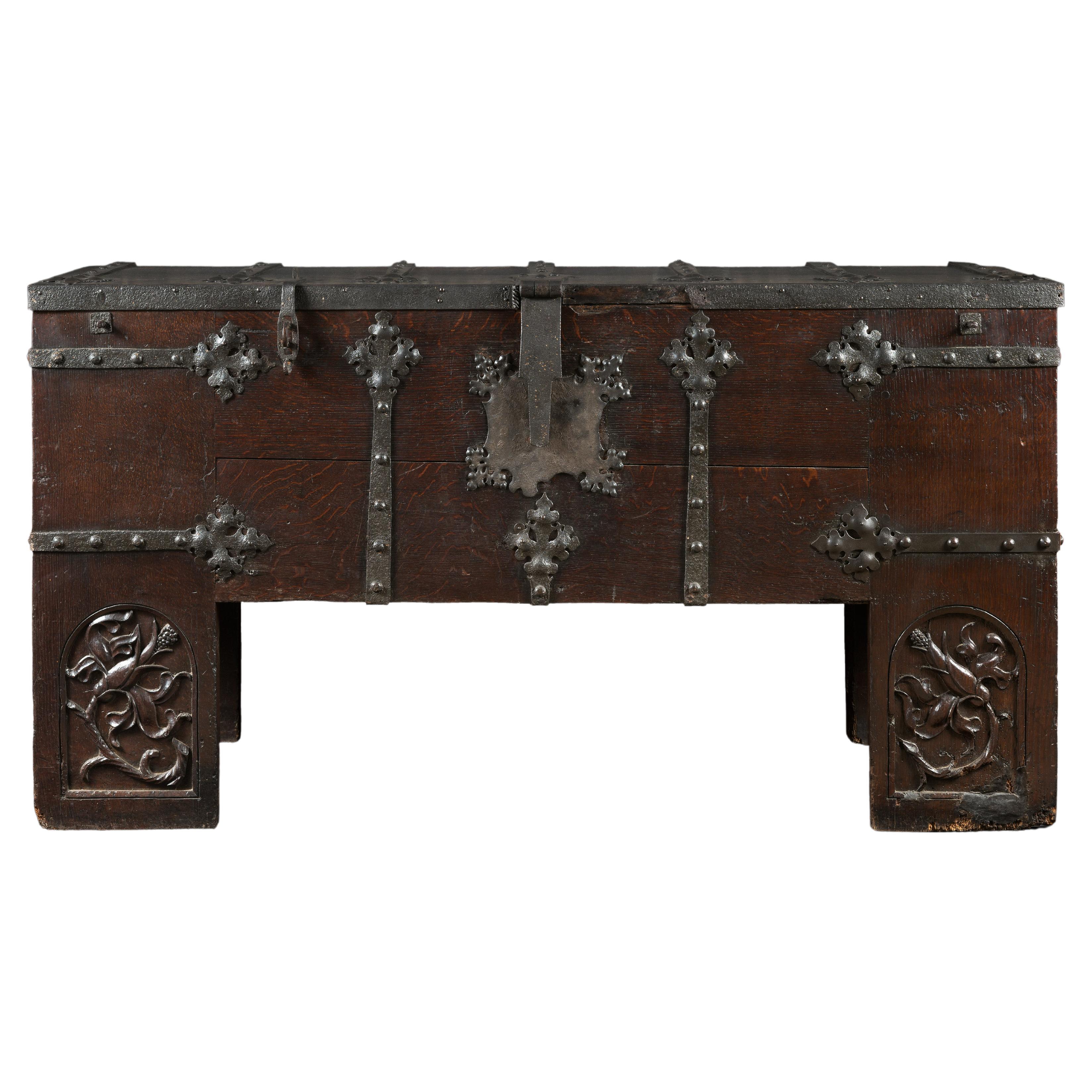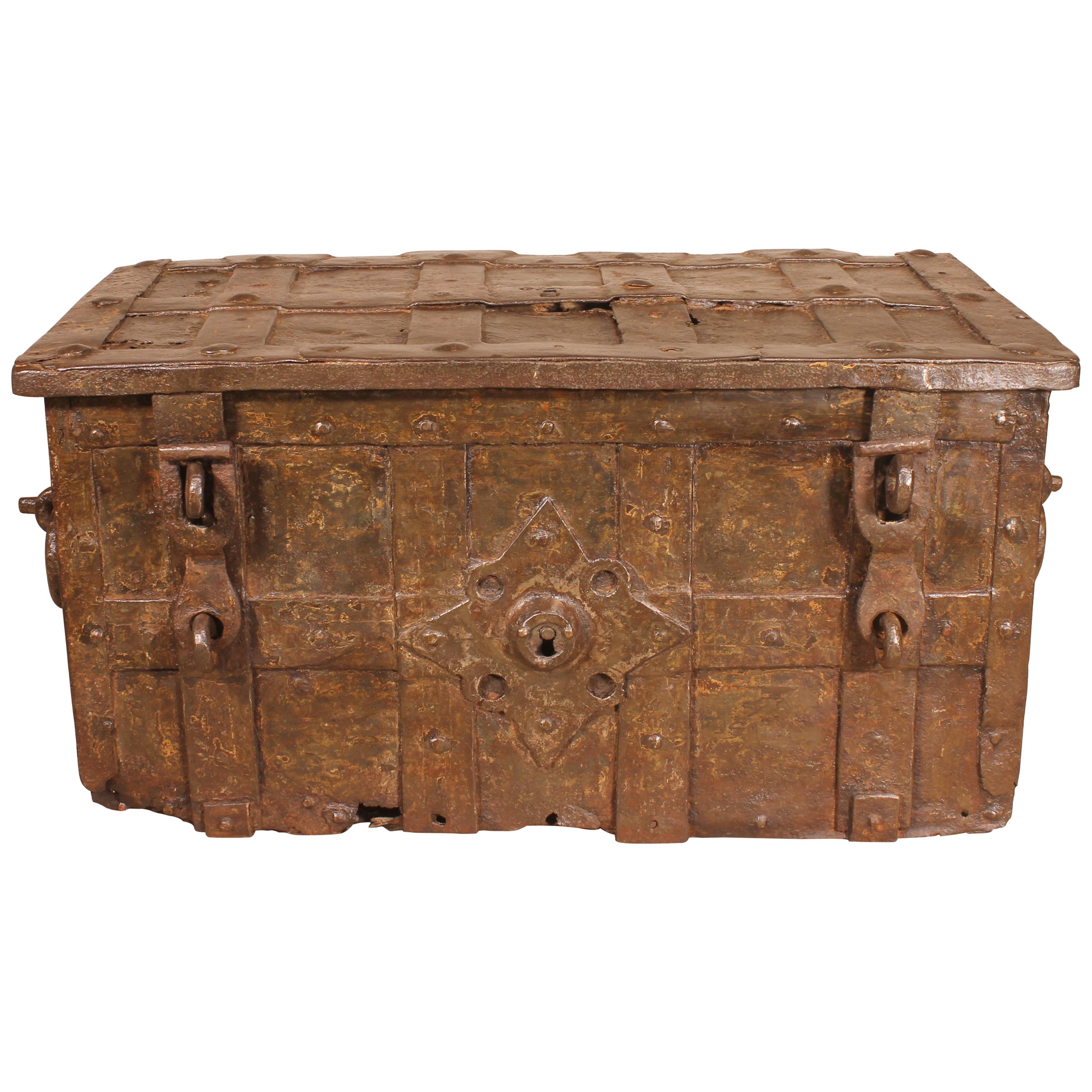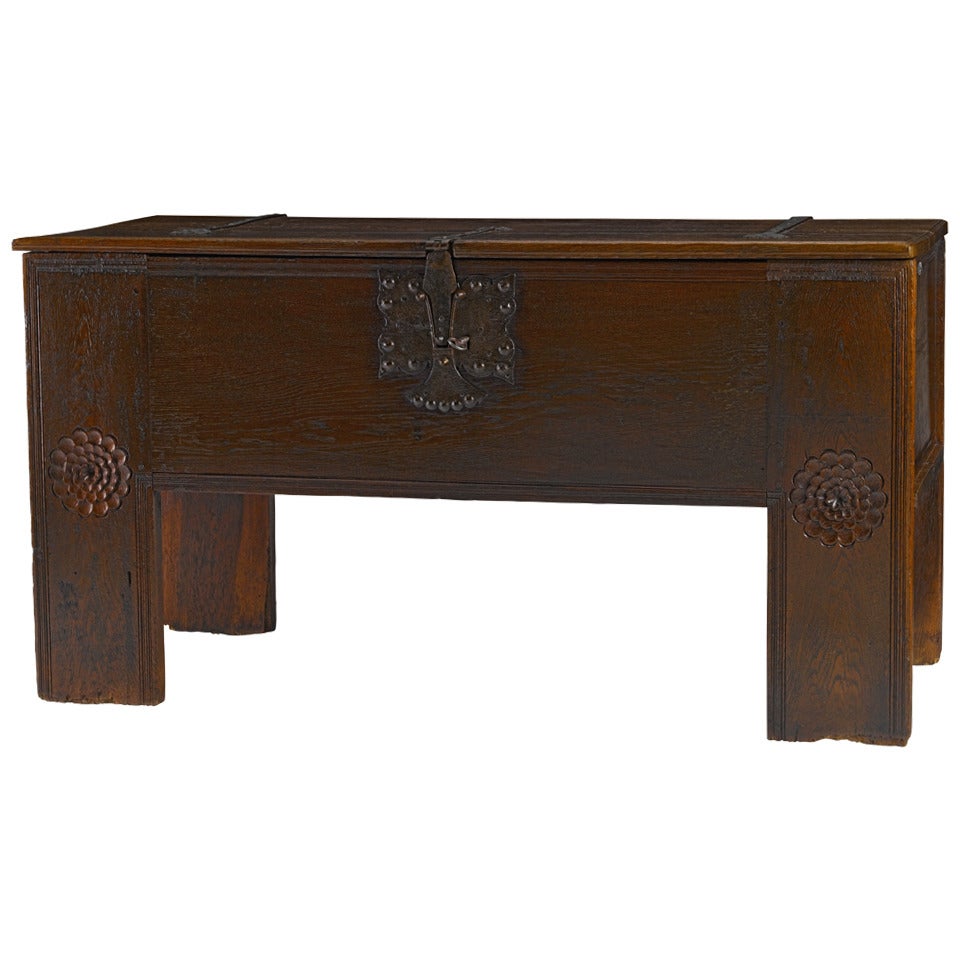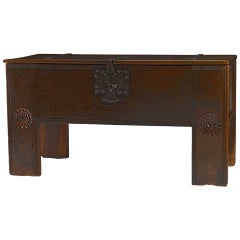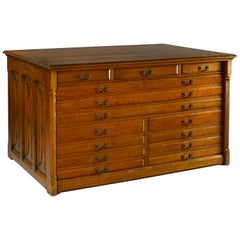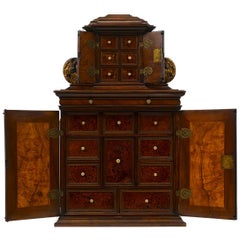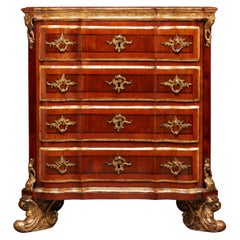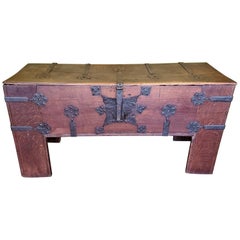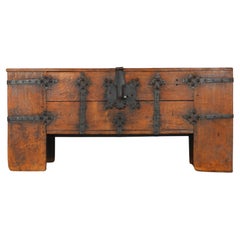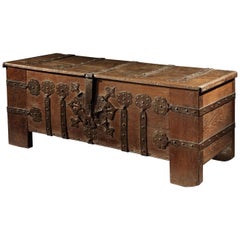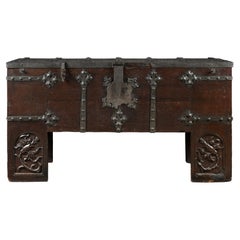Items Similar to Rare Late Medieval 16th Century German Wrought Iron Oak Chest or Stollentruhe
Want more images or videos?
Request additional images or videos from the seller
1 of 13
Rare Late Medieval 16th Century German Wrought Iron Oak Chest or Stollentruhe
$58,689.25
£43,491.96
€49,000
CA$80,121.98
A$89,132.42
CHF 46,724.33
MX$1,089,176.41
NOK 594,976.06
SEK 560,087.65
DKK 373,081.69
Shipping
Retrieving quote...The 1stDibs Promise:
Authenticity Guarantee,
Money-Back Guarantee,
24-Hour Cancellation
About the Item
A very impressive Westphalian Gothic chest or ‚Stollentruhe’, Westphalia, Germany, circa 1500-1550. Wrought iron mounted oak, partially carved. The monumental rectangular standing chest with full-height stiles, extensively mounted with wrought ironwork straps terminating in quatrefoil finials which ’wrap’ around the chest edges. These are fixed with convex head nails. The ironwork with some remains of an originally red painted surface. In addition, running along the edges of the lid at the front and sides is a plain iron band, close-nailed. The feet of the two front legs are finely carved on the front face, in low relief with a rectangular arched ’panel’ depicting on the left a lion, on the right a dragon holding each a coat of arms.
Regarding the age of circa 500 years, this coffer is in exceptionally good condition, with only smaller restorations.
Comparative literature
• Baumeier, Stefan, Beschlagene Kisten; Die ältesten Truhen Westfalens, Essen, 2012.
• Falke, Otto von, Deutsche Möbel des Mittelalters und der Renaissance, Stuttgart, 1924.
• Kreisel, Heinrich, Die Kunst des deutschen Möbels, Von den Anfängen bis zum Hochbarock, München, 1968, Band I.
• Stülpnagel, Karl Heinrich von, Die gotischen Truhen der Lüneburger Heideklöster, Cloppenburg, 2000.
• Windisch-Graetz, Franz, Möbel Europas, Band I, Von der Romanik zur Spätgotik, München, 1982.
- Dimensions:Height: 38.19 in (97 cm)Width: 81.11 in (206 cm)Depth: 27.96 in (71 cm)
- Style:Medieval (Of the Period)
- Materials and Techniques:
- Place of Origin:
- Period:
- Date of Manufacture:circa 1500-1550
- Condition:Wear consistent with age and use. Minor losses. Detailed condition report on request. Fantastic and authentic overall condition!
- Seller Location:Worpswede / Bremen, DE
- Reference Number:Seller: 38691stDibs: LU981410982443
About the Seller
5.0
Recognized Seller
These prestigious sellers are industry leaders and represent the highest echelon for item quality and design.
Established in 1979
1stDibs seller since 2013
27 sales on 1stDibs
Typical response time: 1 to 2 days
- ShippingRetrieving quote...Shipping from: Worpswede / Bremen, Germany
- Return Policy
Authenticity Guarantee
In the unlikely event there’s an issue with an item’s authenticity, contact us within 1 year for a full refund. DetailsMoney-Back Guarantee
If your item is not as described, is damaged in transit, or does not arrive, contact us within 7 days for a full refund. Details24-Hour Cancellation
You have a 24-hour grace period in which to reconsider your purchase, with no questions asked.Vetted Professional Sellers
Our world-class sellers must adhere to strict standards for service and quality, maintaining the integrity of our listings.Price-Match Guarantee
If you find that a seller listed the same item for a lower price elsewhere, we’ll match it.Trusted Global Delivery
Our best-in-class carrier network provides specialized shipping options worldwide, including custom delivery.More From This Seller
View All17th Century German Iron-Mounted Oak Chest / Trunk "Stollentruhe"
Located in Worpswede / Bremen, DE
A 17th century German oak chest ("Stollentruhe") in the medieval/ Gothic tradition. The rectangular hinged top with three iron straps, enclosing a plain interior with one hinged smal...
Category
Antique 17th Century German Baroque Commodes and Chests of Drawers
Materials
Oak
Rare Victorian Mid-19th Century Gothic Revival Library Architects Plan Chest
Located in Worpswede / Bremen, DE
A neo-gothic mid-19th century library plan chest having an arrangement of eleven short and three long drawers to one side, the other side with three short drawers above gothic style linen fold panelling, centred with the carved monogram ‘HP’, further matching panelling to the sides. A stunning plan chest of good propartions and with a nice patina. Provenance: Sherborne School, an independent school in north-west Dorset, England, established in 1550. Among the ‘Old Shirburnians’ are for example the writer John Cowper Powys, the actors Jeremy Irons und Charlie Cox, Chris Martin, leadsinger of the band Coldplay as well as Sheikh Tamim bin Hamad Al Thani...
Category
Antique Mid-19th Century English Gothic Revival Commodes and Chests of D...
Materials
Oak
Rare 17th Century Baroque Cabinet, South Germany Probably Augsburg, Wunderkammer
Located in Worpswede / Bremen, DE
A small architectural table cabinet, veneered in walnut and mulberry, the centre doors enclosing an arrangement of nine various sized drawers with bone knobs, behind a central door a...
Category
Antique Late 17th Century German Baroque Cabinets
Materials
Brass
Danish 18th Century Rococo Walnut Commode Mathias Ortmann
By Mathias Ortmann
Located in Worpswede / Bremen, DE
A very charming and small Danish parcel-gilt walnut and burr-walnut commode by Mathias Ortmann, mid-18th century. The shaped veneered top above moulded frieze with punched ground inc...
Category
Antique Mid-18th Century Danish Rococo Commodes and Chests of Drawers
Materials
Bronze
Swiss Early 19th Century Empire Bureau Cabinet, Signed Hirschgartner
Located in Worpswede / Bremen, DE
This fine Empire drop-front secretary (secrétaire a'abattant or secrétaire en armoire) with a writing and standing desk is signed M. Hirschgartner. Hans Martin Hirschgartner (1766-18...
Category
Antique 19th Century Swiss Empire Secretaires
Materials
Marble
Important Early 19th Century Danish Neoclassical Secretaire NIcolai Abildgaard
By Nicolai Abildgaard
Located in Worpswede / Bremen, DE
The slender secretaire on an unusual high stand with four curved legs dived into quarters, the frame with a central inlaid palmette motif. The fall down writing flap, enclosing a fitted interior with numerous drawers, above and below are two doors enclosing one shelf. The top of the secretaire in form of a classical triangular pediment, the center of which is decorated with an inlaid stylized anthemion. The entire front is very plain and geometrical, divided into six panels inlaid with rectangular fields in light wood.
The design of this mahogany secretaire is based on classical Roman and Greek models, in this case the bookcases that were portrayed on frescoes, reliefs and Roman gold glass. As secretaires were not known in Antiquity, Abildgaard designed his secretaire as a cupboard though in such a way, that the two centre doors are actually a fall front writing top. The carved turned underframe is inspired by Etruscan footstools, which were known especially from reliefs and had been reproduced in contemporary prints. Abildgaard designed this piece of furniture far more in accordance with ancient tradition than did the other furniture designer of the day. The most important (and avantgarde) piece of the furniture Abildgaard designed in the first decade of the 19th century, is this secretaire, which marks a real renewal in relation to the secretaires that constituted the master's test for the members of the guild of cabinetmakers at this time. Compared with these, this secretaire is a very light piece of furniture that does not follow the contemporary fashion towards classical architectural decorations such as columns, pillars, architraves, etc. which often endow such pieces.
Nicolai Abraham Abildgaard (11 September 1743 – 4 June 1809) was a leading Danish Neoclassical painter who also designed (mostly for his own use) elegant Grecian furniture...
Category
Antique Early 19th Century Danish Neoclassical Secretaires
Materials
Bone, Maple
You May Also Like
Rare (Late Medieval) 16th Century German Wrought Iron Oak Chest or Stollentruhe
Located in Dallas, TX
WE HAVE THE PLEASURE TO PRESENT an Exceptionally Rare (Late Medieval) 16th Century German Wrought Iron Oak Chest or Stollentruhe.
This is an Early...
Category
Antique 16th Century German Gothic Blanket Chests
Materials
Wrought Iron
Rare Late Medieval 16th Century German Wrought Iron Oak Chest
Located in grand Lancy, CH
A very impressive Westphalian Gothic chest or ‚Stollentruhe’, Westphalia, Germany, circa 1500-1550. Wrought iron mounted oak, partially carved. The monumental rectangular standing ch...
Category
Antique 16th Century German Commodes and Chests of Drawers
Materials
Iron
Chest or Stollentruhe, Early 16th Century, German Gothic, Oak Chest, Original
Located in BUNGAY, SUFFOLK
This standing chest is of clamp-front construction, extensively decorated with long, ironwork straps with quatrefoil finials which ‘wrap’ around it, and has an ornate, central lockplate, and front legs with full, height stiles. The ironwork straps and finials are fixed with convex, headed nails: running along the front, five long straps; the two side straps; and the five straps on the top. On the chest front, centrally placed, is a large, iron lockplate with four outer, radiating spade finals in each corner and three, superimposed spade finials (a symbol of nobility) which are pierced with the initials ‘BB’. The lockplate receives a corresponding, external hasp fitted to the lid. Below the floor of the chest, the two front stile legs retain most of their original height. The lid is supported by substantial iron strap hinges that extend right down the back of the chest. Inside the chest at the left end is a shallow, oak till.
Construction The chest is of joined, 'clamp-front' construction, reinforced by the nailed, iron mounts. In total it uses ten, oak boards which were riven and planed. The back and front are each formed from a large single plank held to the full height stiles by long, pegged tenons. The sides are also single boards joined into the stiles using long tenons held by dowels, and extend down below the chest bottom, concealing the ends of the bottom boards. The bottom consists of a single board cut into the sides and shallow rebates in the stiles. The front and back boards are dowelled into the bottom boards. The lid which overhangs the sides has a narrow cleat at each end, and consists of one wide plank which has bowed a little as a result of shrinkage.
Ironwork : The wrought ironwork straps, lockplate, hasp and lock all appear all appear to be early, and of the same original manufacture and are fixed with convex headed nails. There is mild dark staining of the oak around the iron mounts, possibly because of low tannin content in the oak.
Length 172 cm., 67 ¾ in., Height 71.5 cm., 28 ¼ in., Depth 63 cm., 24 ¾ in.,
Related to: No 900:2-1904 V&A Museum, London. Stadtmuseum Dusseldorf. Decorative Arts Museum Berlin. Museen Schleswig-Holstein & Hamburg. A related example featuring elaborately-carved feet and formerly in the Horsham Museum, West Sussex, sold at Christie's in 2010 for £97,250 and another example, again with carved feet sold at Sothebys in 2006 for £48,000.
Literature: A similar example is illustrated in H. Lüttgens, Alt- Aachener Wohnkultur; Ein Rundgang durch ein altes Aachener Haus im Wohnstil des 18. Jahrhunderts, Aachen, n.d., ill. 12, and another comparable iron-bound chests...
Category
Antique 16th Century German Gothic Blanket Chests
Materials
Oak
Rare Gothic German Oak and Iron Chest Known as "Stollentruhe"
Located in Saint-Ouen, FR
This large chest stands on high legs prolonging the lateral jambs. Presenting a sober and severe appearance the chest still belongs to the Medieval tradition. The piece is made from very high quality Hungarian wood.
The jambs are joined to the facade and the lateral sides thanks to pegged mortise and tenon securing a great stability and squareness between each parts. The upper lid is made of two joined parts and so is the facade.
The ironwork is present all over the surface of the chest and brings both an additional stability to the construction as well as a rich decor. The lid is secured with hinges. Hinges also run all over the chest in horizontal and vertical lines, ending in a floral motif. The hasp lock is also very ornamental.
Those chests always present important proportions especially when they are made early in the period. This model was very popular in Germany and stayed in vogue until the 16th century. However the feet Gothic decor...
Category
Antique 15th Century and Earlier German Gothic Blanket Chests
Materials
Wrought Iron
17th Century Nurenberg Chest in Wrought Iron
Located in Brussels, Brussels
Nuremberg chest or corsair chest from the 17th century from Germany Nuremberg
Very elegant chest with a beautiful patina
In his original state
The l...
Category
Antique 17th Century German Renaissance Blanket Chests
Materials
Iron
16th Century Flemish Oak Strong Box Trunk with Iron Strapwork
Located in Dallas, TX
The beautifully carved front façade is not the only impressive element of this oak strongbox trunk; the interior is reinforced with an iron strapwork “cage”, strengthening the alread...
Category
Antique 16th Century Belgian Renaissance Blanket Chests
Materials
Metal, Iron
More Ways To Browse
Medieval Antique
Antique Medieval Furniture
Antique Iron Chest
Iron Bands
16th Century German
Antique German Chests
Small Oak Chest
German Carved Cabinet
Medieval Panel
Antique Wrought Iron Panel
Red Painted Chests
Lion Chest
Medieval Head
Coat Of Arms German
Antique Red Painted Chest
16th Century Oak
Dior Coat Red
Gothic German
